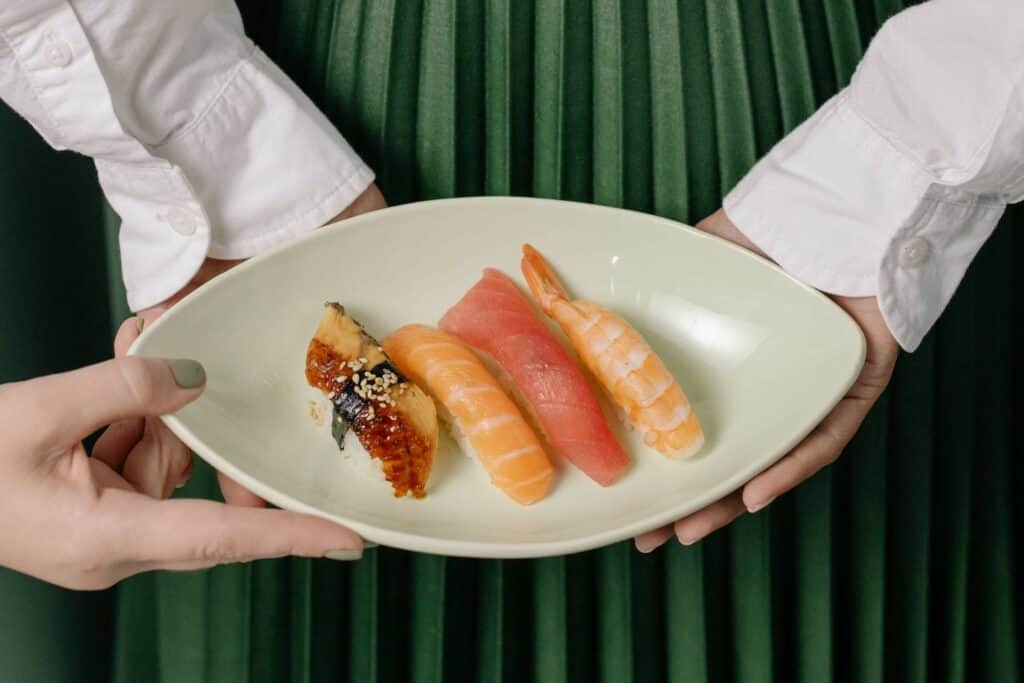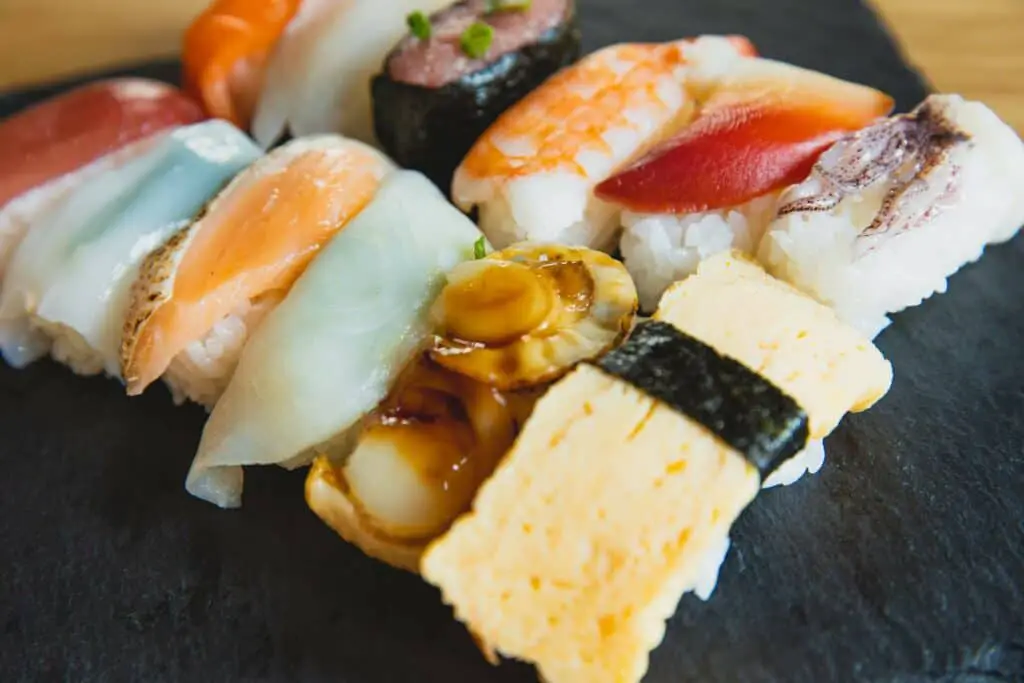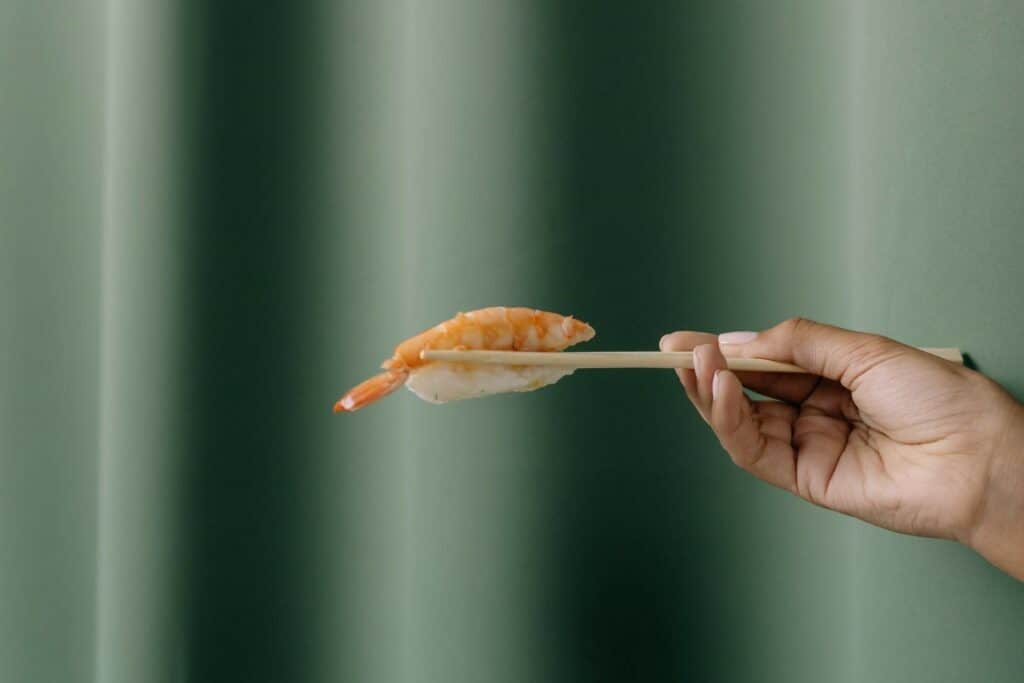When people hear the word “sushi,” they always think of rolls; California and maki rolls seem synonymous with sushi, but overlooking the simple yet powerful nigiri would be a huge mistake. However, is nigiri sushi? You’ll learn more about that here, as well as how professional chefs make this delicious meal.
Yes, nigiri is sushi. It’s one of the meals that fall under the sushi category, together with maki rolls, sashimi, chirashi, and gunkan. Nigiri is a molded lump of rice covered with a fresh piece of meat or vegetables. The most common toppings are raw salmon, tuna, and boiled shrimp. Some nigiri pieces also have eggs or avocado on them.


Is Nigiri Sushi? Learn More About This Simple but Delicious Japanese Dish
To answer this question directly, nigiri is sushi. Not only that, but it’s one of the first sushi inventions to come out of Japan, next to the maki rolls. While the recipe for nigiri is simple, that’s a bit deceiving. It’s not actually that easy to create a perfect-tasting piece.
The quality of nigiri depends on what you add to the rice, if you add anything at all. Most chefs add rice or white vinegar to it, so it’s easier to mold and not get sticky and starchy. The fresh, raw fish toppings need to be the perfect meat slices – not completely raw, but not cooked; not from the freezer nor fridge, but as fresh as possible.
You Can Enjoy Nigiri With Different Toppings
We mostly know nigiri as a lump of rice with a bright orange salmon slice on top. However, there are various toppings to choose from, which you’ll see in any Japanese sushi restaurant. Raw tuna, yellowtail, and albacore are just some types of fish used for nigiri.
Shrimp is boiled and butterflied to create a solid piece for the topping. Some types of nigiri use egg omelet and avocado slices to make vegetarian versions. All these toppings are often wrapped with a thin strip of nori seaweed across the middle so the ingredients can stick together better.
Try Gunkanmaki for an Added Crunch and Umami Flavor
Gunkan is a version of nigiri that includes a third ingredient – nori seaweed sheets. If you dislike the taste of seaweed, gunkan may not be your cup of tea, but for the fans, it’s one of the best delicacies on a sushi plate.
Essentially, gunkan is made the same way as nigiri except for the final step, which is wrapping the nigiri piece with a nori sheet. Salmon or flying fish eggs are often added on top for an extra salty crunch and aesthetic purposes.

Curious to know more about other Japanese delicacies? Read also :
What Is Tobiko?
Hamachi vs Sashimi
Is Tempura Shrimp?
Are Cherry Blossoms Edible?
Are Sushi Rolls Cooked?
How To Make Crab For Sushi
The Inventor of Nigiri Is Also Deemed the Father of Sushi
What we know as sushi today first came to existence during the 1820s and 30s in Tokyo, which was then known as Edo. Chef Hanaya Yohei invented the aesthetic of today’s sushi; until that moment, it was served simply as raw fish on top of vinegared rice.
Yohei perfected the shape and style of nigiri and maki rolls and later named the delicacies Edomaezushi, after the fish he caught in the Tokyo Bay (Edo = Tokyo, mae = bay) used in the recipes.
As far as gunkan, this nigiri variation wasn’t invented until 1941, when a chef in the famous Japanese restaurant Ginza Kyubey decided to try a new recipe. Gunkan introduced a variation of sushi that upped the game for the restaurant, both in terms of sales and popularity.
Some Basics of Making Nigiri, Also Known as Nigirizushi
If you want to try a simple nigiri recipe at home, there’s not much you have to know about its ingredients. The topping can be anything you like, from eggs and avocados to actual raw or fried fish.
It’s highly recommended to use sushi rice as its texture is the most suitable for shaping and molding. Shaping rice in nigiri is achieved by slightly cupping the hands and using the fingers to create a smooth, oblong shape. There’s no particular technique; just ensure it doesn’t fall apart as you mold it.
Tips for Using Fish Toppings
If you’re not a fan of raw fish or aren’t sure how to prepare it on your own, that’s understandable. Raw fillets are scary, and many people avoid eating sushi because of them. However, you don’t have to leave your fish uncooked. Many restaurants serve slightly fried pieces of tuna or salmon on nigiri.
You can also buy pre-smoked salmon in a store or supermarket. These usually come sliced, packaged, and sealed, and they’re a trendy ingredient among people looking to eat healthy today. These would make perfect toppings for beginner nigiri-makers.
How to Prepare the Shrimp Toppings for Nigiri
Suppose you like a challenge and want to make a shrimp-topped nigiri. Firstly, you have to clean and boil the shrimp. When it’s cooked and flavored, slice it across the middle to butterfly it; place on top of the rice, and you’re ready to eat.
If you dislike the taste of boiled shrimp, you can skewer and grill or bake them. The important part is to push the skewer through the middle as much as possible; this will straighten out the shrimp and make it easier to slice across the middle later.

If You’re Looking for Small Bites that Carry a Powerful Punch, Get Some Nigiri Today
While it may seem simple, nigiri can take you on a flavor journey and show you creative ways of using common ingredients. Bland old rice with veggies and fish may not look so boring when it’s plated like sushi. While it seems easy, achieving such perfection takes practice; you can always try to be your own sushi chef and treat yourself to Japanese delicacies at home.